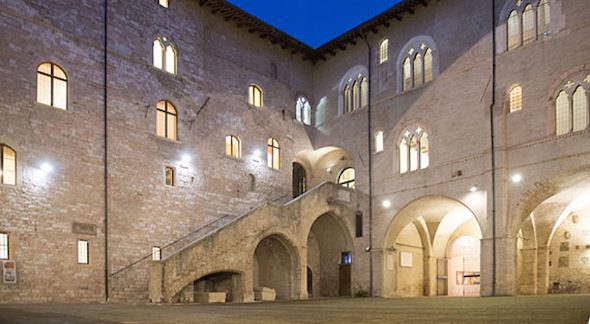Palazzo Trinci è forse il più famoso dei palazzi del centro storico di Foligno, sicuramente una delle più interessanti dimore tardogotiche di tutta l’Italia centrale.
E’ situato sul lato nord di Piazza della Repubblica, nel cuore del centro storico cittadino, e racchiude al suo interno un prezioso ciclo di affreschi dei primi del Quattrocento . Ospita la Pinacoteca civica, il Museo Archeologico e il Museo multimediale dei tornei, delle giostre e dei giochi.
Storia del Palazzo Trinci di Foligno
Alla fine del Trecento, la famiglia Trinci che già risiedeva nel centro di Foligno decise di ampliare la propria dimora e acquistò case e torri adiacenti da un ricco mercante locale. Gli edifici vennero poi ristrutturati in modo da costituire un unico grande complesso, con i lavori che si conclusero nel 1407. Il primo Quattrocento fu d’altronde un’epoca d’oro per i Trinci, che ospitarono a palazzo molti studiosi ed umanisti luminari dell’epoca, tra i quali Francesco da Fiano.
Pare che fu proprio quest’ultimo ad ispirare gli affreschi di Gentile da Fabriano, realizzati dall’artista in collaborazione con altri pittori della sua bottega, che costituiscono una sorta di
“vera e propria enciclopedia figurata della cultura umanistica dell’epoca”.
A seguito di varie vicissitudini familiari e politiche, il palazzo divenne per lungo periodo un possedimento dello Stato Pontificio.
Subì negli anni diverse modifiche, le più significative furono:
- la facciata a metà dell’Ottocento, ristrutturata in stile neoclassico a seguito dei danneggiamenti del terremoto del 1832
L’esterno presenta infatti semicolonne decorative e una particolare sorta di cavalcavia verso la cattedrale, l’antico accesso che un tempo collegava le abitazioni costruite sulla navata laterale.
- restauri di alcuni ambienti interni e affreschi negli anni ’30, come la Sala Sisto IV
- il cortile a varie ale dell’edificio, ricostruite a seguito dei bombardamenti che interessarono la zona nel 1944
Il cortile si caratterizza per i portici con pilastri e le grandi volte a crociera.
- vari restauri interni a seguito dei danni del terremoto del 1997
Gli affreschi del Museo di Palazzo Trinci
>>Vuoi visitare Foligno? Consulta ora le offerte dei migliori hotel a Foligno
Dal cortile si può accedere al palazzo tramite una scala in stile gotico, oggi chiusa da un lucernaio. Raggiungendo il secondo piano si arriva agli ambienti monumentali affrescati principali, a partire dalla Sala Sisto IV e i suoi motivi ornamentali.
Proseguendo si passa alla Sala dei Giganti, affrescata con illustri figure ed imperatori che hanno segnato l’antica storia di Roma
Di fronte alla scala gotica è collocata invece la cosiddetta Loggia di Romolo e Remo, con gli affreschi dedicata proprio alla leggenda dei due mitici fondatori di Roma.
Salendo da qui, si accede alla Sala delle Arti Libere e dei Pianeti, la più bella e certamente la più famosa di tutto il complesso del palazzo.
Si tratta di un complesso insieme iconografico di figure monumentali e motivi ornamentali: in parte della stanza sono rappresentate le Arti Liberali, raffigurate come simboliche donne occupate ad istruire giovani ragazzi;
Le arti raffigurate sono facilmente riconoscibili:
- la Grammatica sulla sinistra, una donna che intenta a far leggere un bambino
- la Dialettica, un’anziana con in mano dei serpenti simbolo di astuzia e ingegno
- la Musica, intenta a suonare un organetto
- la Geometria, collocata sulla parete di fondo, che stringe una sezione di cerchio e un compasso
- la Filosofia – andata purtroppo perduta – si trovava al centro e corrispondeva alla regina delle arti
- l’Astronomia, che consulta un libro aperto e indica un astrolabio
- l’Aritmetica, la donna sulla parete ovest che aiuta un giovane a contare
- la Retorica, l’anziana con in mano la verga simbolo di autorità
Nell’altra parte della stanza, troviamo invece una suggestiva rappresentazione di pianeti alternati a dischi iridati, che richiamano l’Età dell’Uomo e le Ore del Giorno.
Si segnala infine l’attiguo corridoio, in origine spazio di collegamento tra palazzo e cattedrale.
All’interno del Palazzo Trinci inoltre sono oggi state ricollocate le raccolte civiche folignati e la struttura si presta ospitate le principali esposizioni della città.



Comment (0)